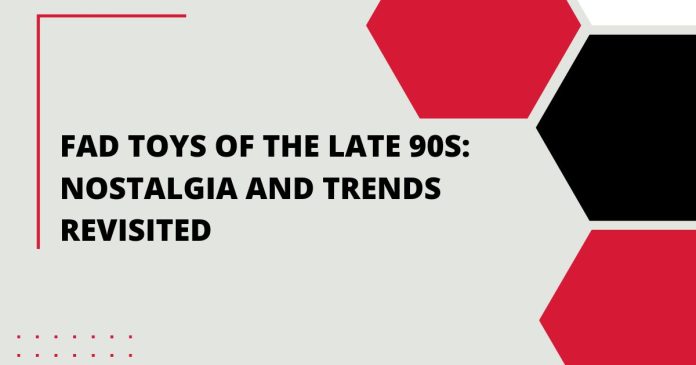Remember the late 90s, when every kid on the block was obsessed with the latest fad toys? Those were the days of collecting and trading, where playground conversations revolved around which toy was the coolest. From virtual pets to collectible cards, the fad toy of the late 90s left an indelible mark on pop culture and childhood memories. In this article, we’ll take a trip down memory lane and revisit some of the most iconic fad toys that defined that era.
Table of Contents
- Introduction
- Tamagotchi: The Virtual Pet Sensation
- Beanie Babies: Collectible Cuteness
- Pokémon Cards: Gotta Catch ‘Em All
- Furby: Talking and Interactive Toy
- Yo-Yos: The Resurgence of an Old Classic
- Super Soakers: Splashes of Summer Fun
- Pogs: Milk Caps Mania
- Tickle Me Elmo: Laughter in Plush Form
- Game Boy Color: Handheld Gaming Revolution
- Giga Pets: The Competitor to Tamagotchi
- Talkboy: Inspired by Hollywood
- Lite-Brite: Illuminating Creativity
- Easy-Bake Oven: Mini Culinary Delights
- Conclusion
Introduction
The late 90s marked an era of explosive creativity in the toy industry, giving birth to fad toys that captured the hearts and imaginations of children worldwide. These toys weren’t just playthings; they were cultural phenomena that defined a generation’s childhood.
Tamagotchi: The Virtual Pet Sensation
In 1996, the Tamagotchi burst onto the scene, introducing the concept of virtual pet ownership. These small, egg-shaped devices contained pixelated pets that required feeding, playing, and care, mimicking the responsibilities of real pet ownership.
Beanie Babies: Collectible Cuteness
Beanie Babies, with their plush designs and heartwarming names, became a sensation in the late 90s. Collectors and enthusiasts rushed to acquire rare and limited editions, hoping they would someday appreciate in value.
Pokémon Cards: Gotta Catch ‘Em All
Pokémon, a cultural phenomenon in itself, extended its reach into the trading card world. Pokémon cards became a currency of playground trades, with kids hoping to collect the rarest and most powerful cards to assert their status.
Furby: Talking and Interactive Toy
Furby, a peculiar furry creature, captivated children with its ability to speak and learn. With its expressive eyes and quirky interactions, Furby was more than just a toy—it was a companion.
Yo-Yos: The Resurgence of an Old Classic
The late 90s saw the resurgence of yo-yos, with brands like Yomega and Duncan leading the way. These modern yo-yos weren’t just for simple tricks; they ushered in a new era of skill and creativity.
Super Soakers: Splashes of Summer Fun
Super Soakers revolutionized water fights with their powerful streams of water. These toy water guns turned hot summer days into thrilling battles of soaking fun.
Pogs: Milk Caps Mania
Pogs, a game derived from Hawaiian milk caps, swept through schoolyards like wildfire. Kids collected and traded these circular cardboard discs, competing in games that tested precision and strategy.
Tickle Me Elmo: Laughter in Plush Form
Tickle Me Elmo, a plush toy inspired by the beloved Sesame Street character, created a frenzy of laughter and joy. When tickled, Elmo’s infectious laughter filled households, making it one of the most sought-after toys of the era.
Game Boy Color: Handheld Gaming Revolution
The Game Boy Color brought color to the world of handheld gaming. With classics like Pokémon and Mario, it provided endless entertainment on road trips and lazy afternoons.
Giga Pets: The Competitor to Tamagotchi
Giga Pets entered the virtual pet scene as a competitor to Tamagotchi. These keychain-sized pets offered different gameplay experiences, giving kids more options for nurturing their digital companions.
Talkboy: Inspired by Hollywood
Inspired by the movie “Home Alone 2,” the Talkboy allowed kids to record and manipulate their voices. It was a toy that combined entertainment with imagination.
Lite-Brite: Illuminating Creativity
Lite-Brite allowed children to create vibrant pictures by placing translucent pegs onto a lit board. It was a fusion of art and technology that celebrated creativity.
Easy-Bake Oven: Mini Culinary Delights
The Easy-Bake Oven made aspiring chefs out of kids. It allowed them to bake miniature treats and explore the world of culinary arts from a young age.
Conclusion
The fad toys of the late 90s weren’t just playthings; they were symbols of a vibrant era that celebrated imagination, creativity, and innovation. These toys shaped our childhoods and continue to evoke fond memories as we look back on simpler times.
FAQs
- What were Pogs, and why were they so popular? Pogs were circular cardboard discs that kids collected and played with in various games. Their popularity surged due to their addictive gameplay and collectible nature.
- Which fad toy was inspired by a Hollywood movie? The Talkboy, inspired by “Home Alone 2,” allowed kids to record and manipulate their voices for fun and creativity.
- What made Beanie Babies special compared to other plush toys? Beanie Babies stood out due to their unique designs, heartwarming names, and the promise of potential future value as collectibles.
- How did Tamagotchi influence the concept of virtual pet ownership? Tamagotchi introduced the idea of caring for a virtual pet, teaching kids about responsibility and nurturing.
- What was the significance of the Game Boy Color in handheld gaming? The Game Boy Color brought color graphics to handheld gaming, enhancing the visual experience of classic games like Pokémon and Mario.

